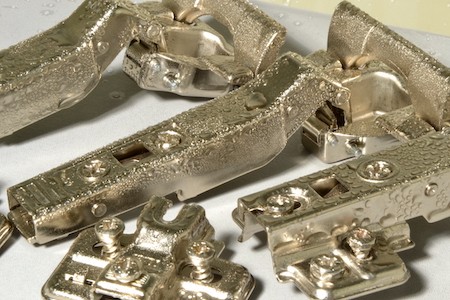 Corrosion
Corrosion has always been a major concern for anyone who has to design or manufacture a metal item, whether painted or protected with galvanic deposition.
One of the best known and consequently most requested tests is the
salt spray test according to the UNI EN ISO 9227 standard (further information
by clicking here). The test is carried out inside a sealed chamber where a solution of water and salt in a 5% concentration at neutral or acid pH is insufflated.
Perhaps not everyone knows, however, that corrosion can also be induced or simulated
with just condensation on the surface of the sample. At the Catas laboratory, it is possible to perform this test, which is described in EN ISO 6270-2. It is certainly
less aggressive than salt spray and it involves an atmosphere inside the chamber saturated with water vapour produced by the evaporation of the water heated at the bottom of the chamber, which, on encountering the cold surface of the sample, settles on it forming a layer of condensation. The temperature is controlled at 40°C and cyclically can be alternated with a cooling phase at room temperature.
It is precisely on the basis of this latter test criteria that most of the
performance checks on furniture fittings, such as
hinges,
shelf supports,
hangers, etc., are based. These products are usually coated with a galvanic deposition that does not offer a high level of protection, such as the visible parts of furniture for which a high level of aesthetics is also required. For this reason, a very strict method such as salt spray may in many cases flatten down all test results and prevent proper product differentiation.
We therefore list the standards of requirements for each type of product:
- EN 17737 Hardware for furniture - Test and evaluation methods for the corrosion resistance of furniture fittings
- EN 15570 Hardware for furniture - Strength and durability of hinges and their components - Hinges pivoting on a vertical axis
- EN 15828 Hardware for furniture - Strength and durability of hinges and their components - Stays and hinges pivoting on a horizontal axis
- EN 15338 Hardware for furniture - Strength and durability of extension elements and their components
- EN 16337 Hardware for furniture - Strength and loading capacity of shelf supports
- EN 15939 Hardware for furniture - Strength and loading capacity of wall attachment devices
- EN 16014 Hardware for furniture - Strength and durability of locking mechanisms
- EN 15706 Hardware for furniture - Strength and durability of slide fittings for sliding doors and roll fronts
According to these standards, corrosion resistance must be measured following the test method described in EN ISO 6270-2 tab. 1.
The requirement is the same for all:
no defects are permitted after 3 AHT cycles.An AHT cycle consists of the followings:
- 8 hours at 40°C at 100% humidity with condensation on the sample
- 16 hours at room temperature.
For info:

 Corrosion has always been a major concern for anyone who has to design or manufacture a metal item, whether painted or protected with galvanic deposition.
Corrosion has always been a major concern for anyone who has to design or manufacture a metal item, whether painted or protected with galvanic deposition.